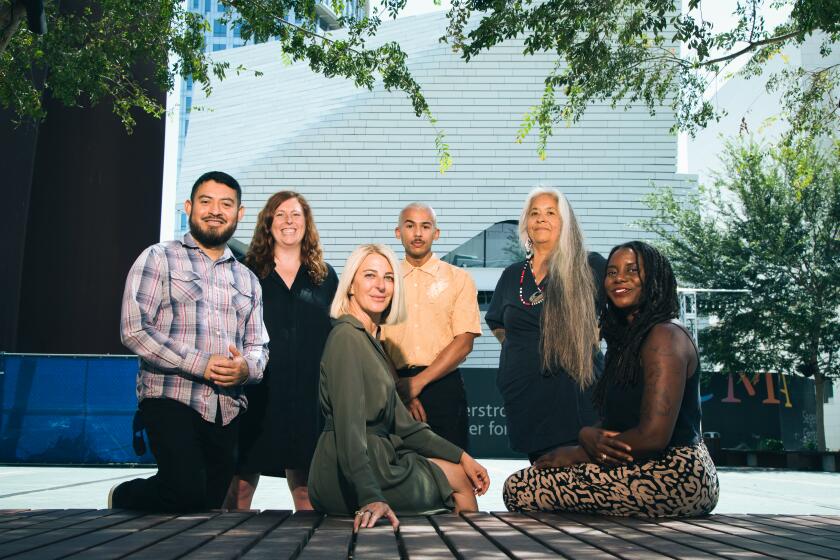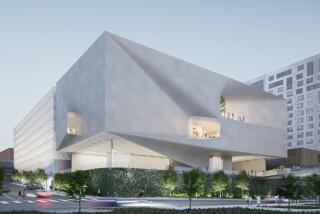Review: OCMA took 35 years to open. But the museum feels more like a gallery crawl
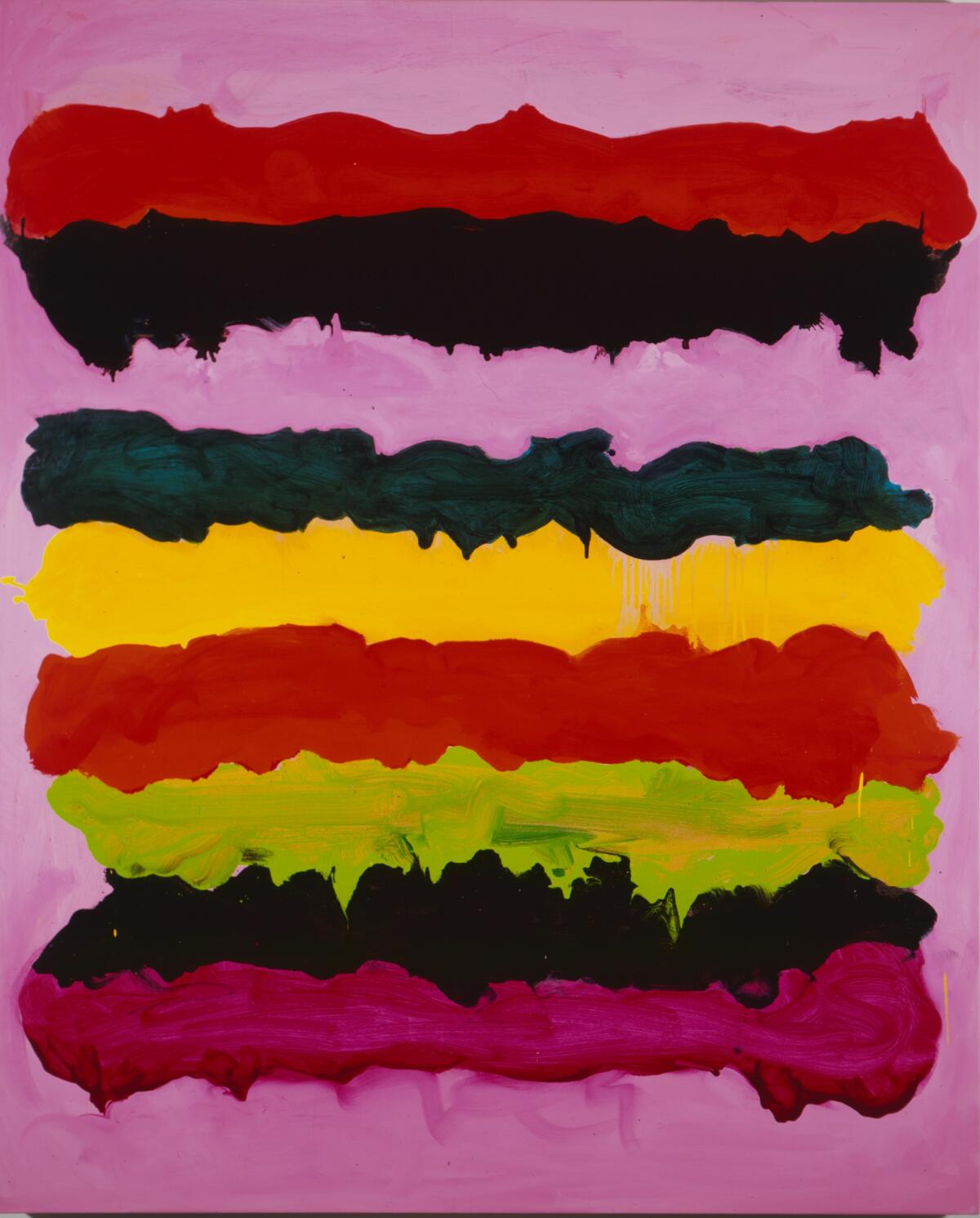
In 1987, the little Newport Harbor Art Museum in Orange County announced plans to erect an expanded and relocated building by a major architect worthy of the museum’s place in a growing, ambitious region of Southern California. The institution was riding the crest of a decade’s worth of often energetic and sometimes surprising exhibitions of Modern and contemporary art, from which it was also acquiring work to expand its permanent collection. All had been produced in a modest, inexpensively built structure tucked behind an upscale shopping center.
This week, the grander vision finally becomes a reality. The new home — a $93 million, 53,000-square-foot edifice designed by Morphosis, led by Pritzker Prize architect Thom Mayne and partner Brandon Welling — opens on Saturday at the Segerstrom Center for the Arts in Costa Mesa. The art offers some prime moments, and with one exception the building should be fine for it. More about that in a moment.
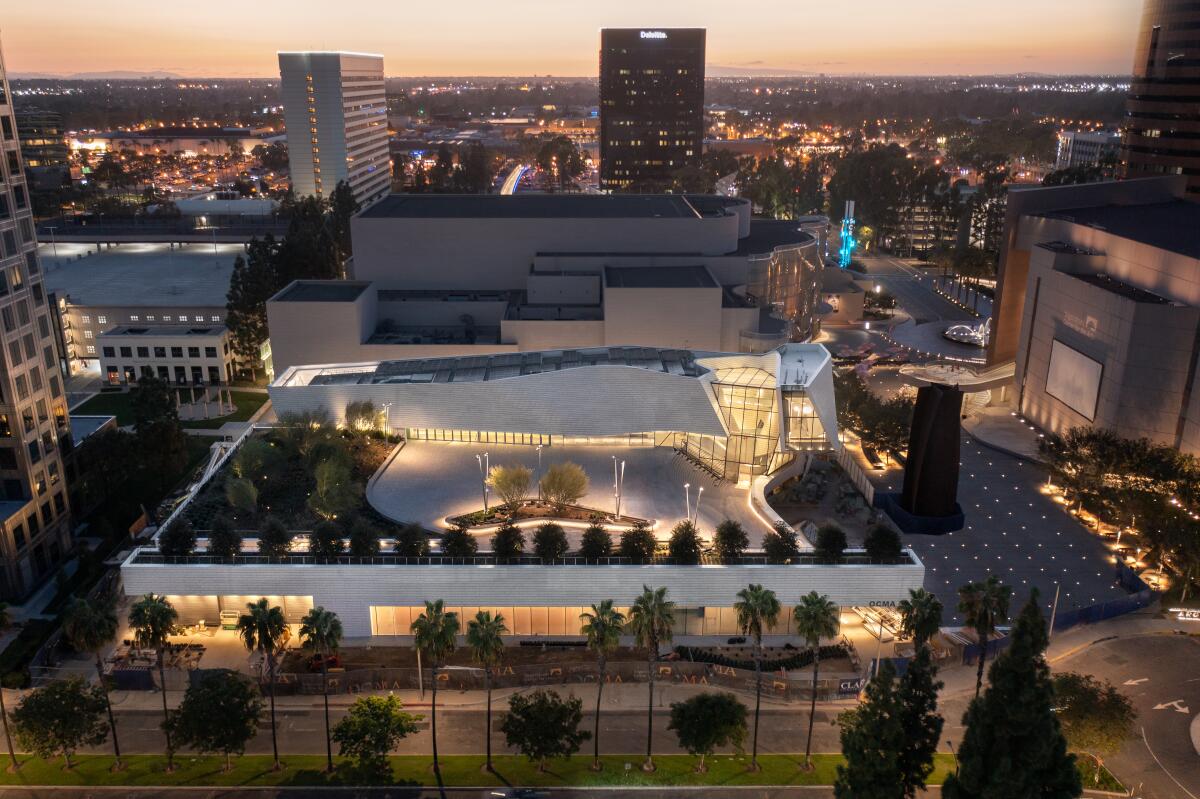
Even in the typically molasses-slow process of building a new art museum, 35 years is a rather protracted wait. (The long-ago aim was to open the new place in an earlier century — 1992.) In the interim, the planned location changed, the architect changed and the staff changed (many times; current director Heidi Zuckerman arrived early last year). The name also changed: Dropping Newport Harbor in favor of the Orange County Museum of Art spoke of a desire to plant the institution in the center of a regional consciousness.
Whether that will happen remains to be seen. It won’t be easy. Segerstrom Plaza is located just off the San Diego Freeway in the heart of a soulless cluster of car-friendly glass office buildings, stucco apartment blocks, hotels and another shopping center. (It’s about a block from “California Scenario,” the elaborate 1982 outdoor environment by estimable sculptor Isamu Noguchi.) Morphosis surely designed the building with the uninspiring site in mind.
From the street, the museum maintains a relatively low profile — horizontal and unadorned, blending into the surroundings. However, at the traffic roundabout where the Avenue of the Arts meets Sunflower Avenue, the place at which many visitors will likely arrive, it rises up, steps back, twists in space and emphasizes fluidity through curved trajectories of tiled walls. Here the structure identifies itself as something distinctly different from everything around it — all the hallmarks of a Morphosis building that push industrial construction into digitally warped visual territory.
The building’s forms play off “Connector,” a towering, 65-foot-high Richard Serra sculpture of torqued steel panels commissioned for the Segerstrom site in 2006. The museum reclines where the sculpture stands tall, folding a wall that leans south where a steel panel bends north. It casually wraps an airy open terrace glimpsed on an upper level, while the adjacent sculpture compresses space in a tight embrace, the sky glimpsed through a narrow aperture at the top. “Connector” has become an exclamation point marking the art museum entrance.
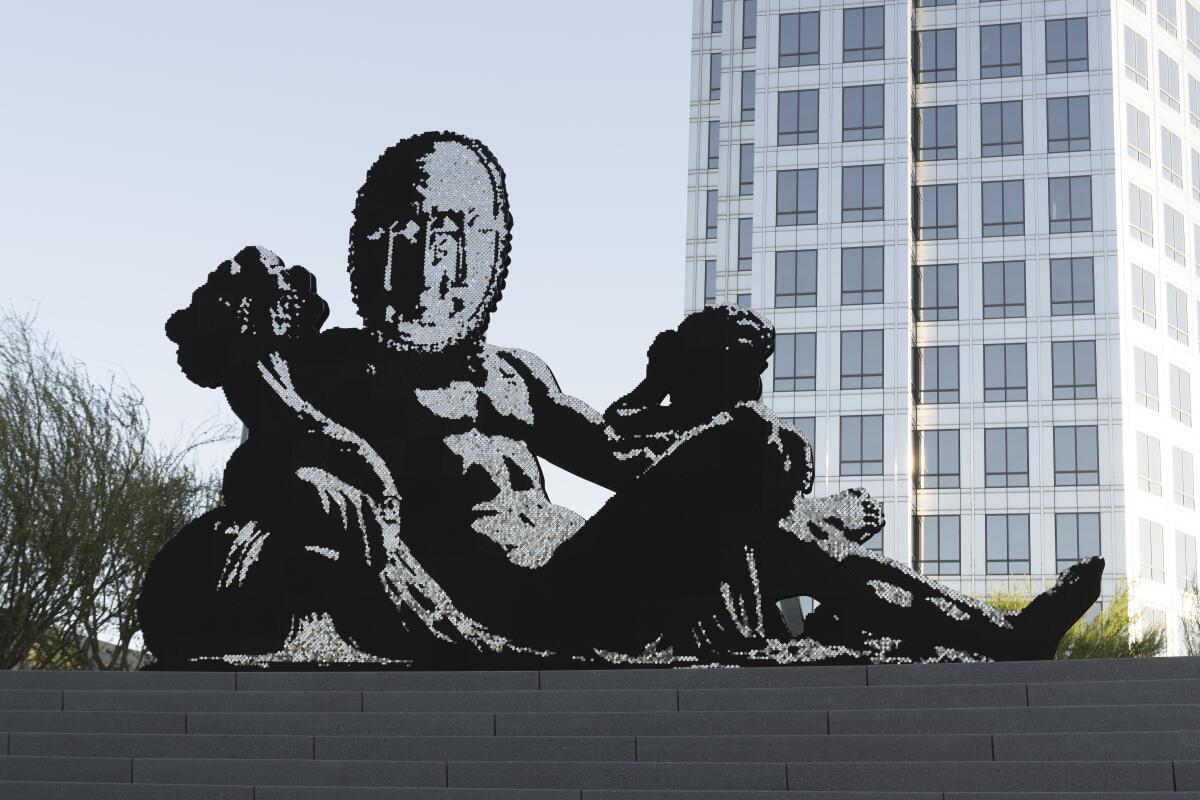
Up on that museum terrace, placed at the top of curved steps that form amphitheater seating, a smart and witty sculpture commissioned from Sanford Biggers, “Of many waters …,” seems to peer over the edge. A cascade of High Art visual references tumbles forth: A reclining male figure — an antique classical nude — suggests something from the Parthenon frieze, plus a melding of clothed and naked figures from Manet’s landmark Modern painting “Luncheon on the Grass,” the exquisite Marcantonio Raimondi engraving of a Raphael Renaissance drawing of river gods that Manet transformed, and more. Biggers manages his own transformation by affixing a Baule double-faced mask to his anonymous hero’s head, adding Africa to the European mix.
A Baule mask functions as an artistic double for its wearer, and Biggers pushes the metaphor. His savvy sculpture, 24 feet wide and 16 feet tall, rendered in black and white like that Raimondi engraving, is in fact two-dimensional. “Of many waters …,” which will remain on view until Feb. 5, is a flat stage set composed of a painted panel held up by struts visible in the back. There, it sports an eye-dazzler Op art pattern.
Perhaps the most encouraging sign in three inaugural OCMA exhibitions is that they’re built to celebrate the museum’s 60-year history. In 1962, an exhibition hall — a kunsthalle — was launched by 13 local women at the Balboa Pavilion on the Newport waterfront as part of a real estate deal. (Welcome to Southern California.) OCMA notes the origin story with “13 Women,” a year-long rotating permanent collection exhibition of art made by women, organized by Zuckerman.
Saturday’s Orange County Museum of Art gala marked the debut of the institution’s new $94 million building, which opens to the public Oct. 8.
Among them is Mary Heilmann’s marvelous abstraction, “Surfing on Acid” (2005), nine layers of horizontal ripples painted in psychedelic colors. Abstract painting — the High Art language of establishment power — gives up sober rigor for skillful, exuberant play.
One of two austere works by Vija Celmins is an exquisitely detailed 1969 drawing, “Moon Surface, Luna 9 #2.” The remoteness of the stony lunar surface stands in visual counterpoint to the soft, tactile touch of pencil pressed to paper.
Nearby, Celmins flips the script. A fool-the-eye painted sculpture of an oversize Eberhard Pink Pearl eraser commemorates a tool that is a necessary counterpoint to making a pencil drawing.
The museum organized the first retrospectives for Heilmann and Celmins, both important artists whose larger impact those shows aided. Point taken.

Other impressive works from the museum’s collection are blended into the mix, including two by Charles Ray — a 1990 self-portrait in the guise of a department store mannequin, and “Ink Box,” a 1986 open cube of black steel filled with 200 gallons of printer’s ink. The quivering meniscus at the top of the box is the subtle giveaway that something about this seemingly solid, 3-foot black cube isn’t quite right.
Ray’s two sculptures are juxtaposed with a wonderful work by Alice Aycock — a big 1980 construction based on an industrial textile loom, which has never been shown before. Aycock’s strangely infernal machine upends historical associations between weaving and delicate women’s work, inserting monumental sculpture into the postindustrial dialogue.
Also on view is the California Biennial, first undertaken in 1984 as a statewide survey of recent art. It returns as “Pacific Gold” with more than 60 works by 19 artists chosen by guest curators Elizabeth Armstrong, Essence Harden and Gilbert Vicario. Without a theme, it instead makes diversity its hallmark, including in materials (painting, sculpture, video, clay, etc.) and in recognition of artists born far afield — Africa to Australia — who choose to work in California.
The Orange County Museum of Art will debut its new building on Oct. 8 with the return of its long-standing California Biennial.
Given the social and political volatility of the present moment, the show does at first seem oddly quiet. Two-plus years of pandemic isolation may have contributed to a larger feeling of hushed concentration that permeates the exhibition, even provided intense subjects.
Some artists are well-known, such as San Diego painter Raúl Guerrero, 77, who has been making significant work for decades. Guerrero’s sly painting shows a Spanish conquistador run aground on a tropical shore. The bumbling arrival is looked at askance by a row of medallions featuring portraits of Indigenous chiefs, as well as by a line of carved, bug-eyed coconuts. Absurdity contributes to tragedy.

Other artists are new to me, including Australia-born Svetlana Shigroff, who works in Joshua Tree. Her large, vividly colored and wildly beautiful tapestry of a devil kissing a skull beneath a shrieking desert sun is part weather report, part document of extreme communal disturbance.
Sharon Ellis, whose exquisite recent works on paper are currently at Kohn Gallery in Los Angeles, shows seven visionary landscape paintings. The rugged terrain and vast sky of the high desert — she also works in Joshua Tree — offers a sacred spectacle of almost hallucinatory beauty.
Alicia Piller built a monument to activist Helen Jones-Phillips, whose son, John Horton, died in a solitary confinement jail cell more than a decade ago. (Jones-Phillips asserts that he was bludgeoned to death by deputies, while officials claim it was a suicide.) The monument is a carousel of physically shredded pictures.
James Gobel makes fragile, lacy paintings without any paint. Instead, he employs an eccentric technique of layered and pinned cut-paper that is more like working with dress patterns — a repudiation of a traditionally masculine ethos of painterly individualism.
A silhouetted “Tree of Life” painted on the wall by Narsiso Martinez is adorned with three dozen plastic supermarket boxes for fruits and vegetables. The tree, an archetype of sacred creation, fuses with commercial fortunes tied to migrant labor.
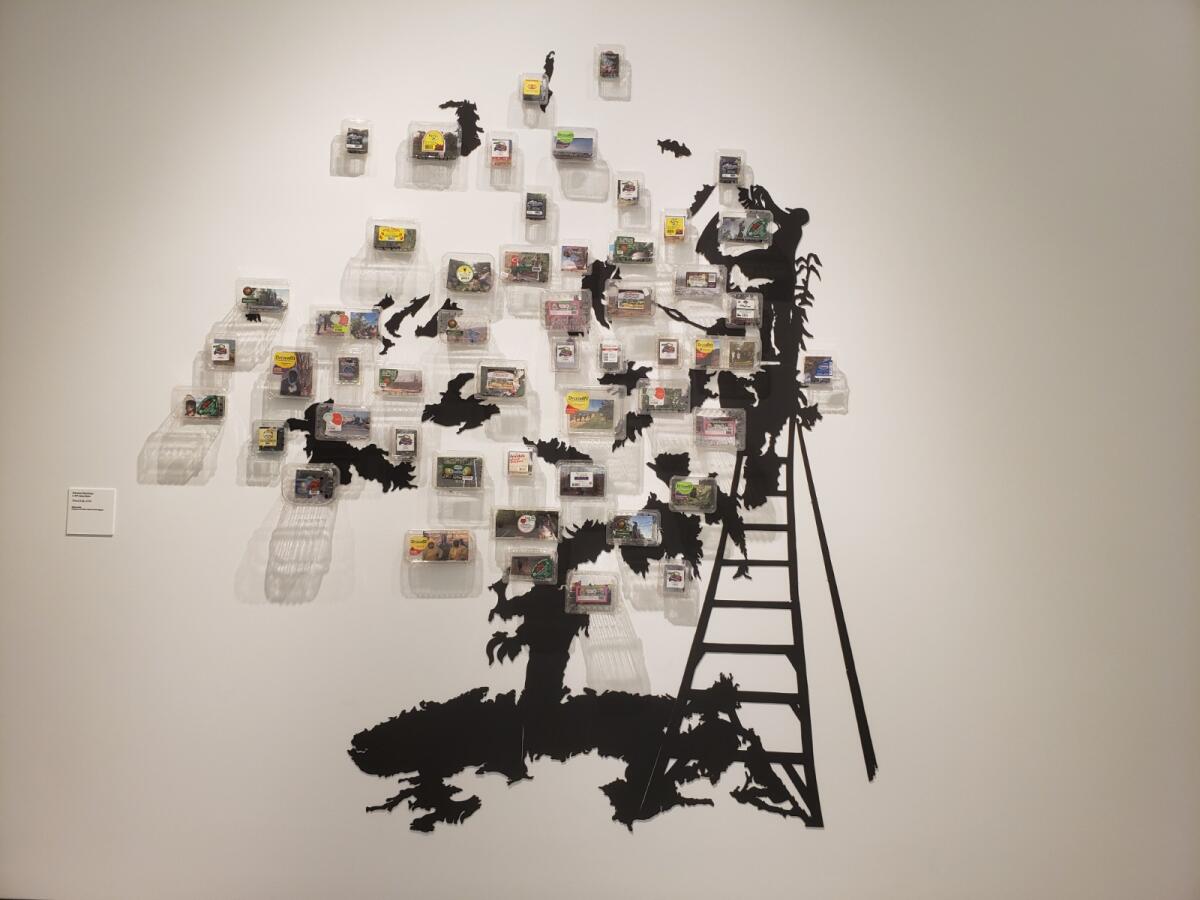
A complaint: It would be nice if OCMA would provide some places to sit within the “13 Women” and Biennial exhibitions, which occupy the lion’s share of the 25,000 square feet of gallery space. On the preview day I visited there wasn’t a chair or bench to be found in either show, including in front of Candice Lin’s enchantingly weird, nearly 20-minute projected video animation of a demonic cat leading survival moves in a bleak landscape. The absence of seating encourages strolling through galleries and sliding by the art, as if on a gallery crawl or at an art fair, rather than stopping to ruminate.
A second installation problem interrupts “Fred Eversley: Reflecting Back (the World),” a show organized by chief curator Courtenay Finn. Cast plastic objects in a wide variety of hues by Eversley, a Los Angeles engineer and sculptor who had his first solo show at the museum in 1976, when he was 35, are mostly circular parabolic lenses, flat on one side and curved like a dish on the other. Predominantly transparent, the sculptures gather light and focus refractions within their colorful optical space. More technically adroit than visually or conceptually engaging, these examples of the Light and Space genre are each shown individually on a welter of some two dozen pedestals, like an expensive display of decorative accessories.
Perhaps the museum’s curators could have used more time to learn the inevitable eccentricities of a brand-new building — which, disconcertingly, is not quite finished. The rush to complete it is most disappointingly evident in an elaborate, geometrically torqued, three-story atrium crisscrossed by pedestrian bridges. A virtual Morphosis signature, the surface finishes are startlingly shabby, with foam core panels that ripple, don’t fit, are mismatched or are incorrectly cut. A cracked window is unnerving.
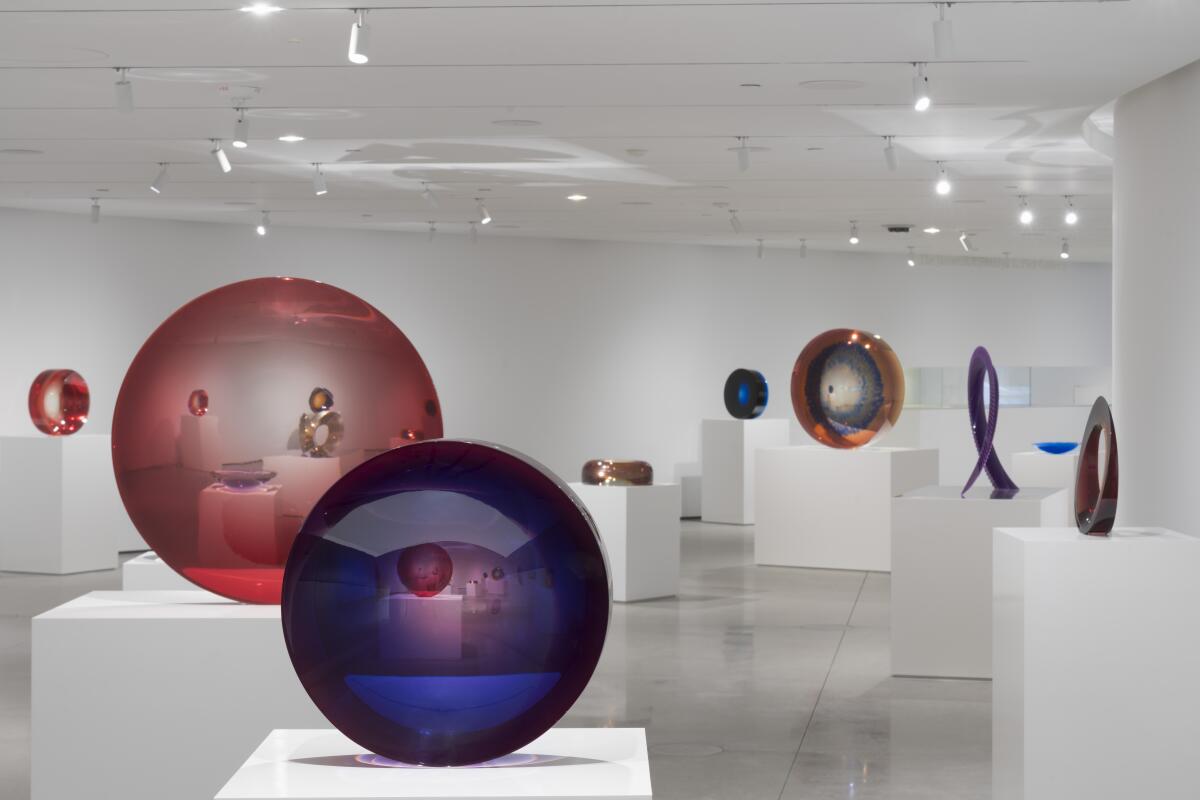
The sloppy finishes are surely temporary, jury-rigged as the scheduled museum opening arrived. A lot of fixing will be needed to make what should be an architectural tour de force sing. I suppose that, after a 35-year wait, what’s a few more weeks or months?
The Orange County Museum of Art
Where: Orange County Museum of Art, 3333 Avenue of the Arts, Costa Mesa
When: 10 a.m.–6 p.m. Tuesday–Wednesday, Sunday, 10 a.m.–8 p.m. Thursday–Saturday. Opens Saturday.
Info: (714) 780-2130; ocma.art
More to Read
The biggest entertainment stories
Get our big stories about Hollywood, film, television, music, arts, culture and more right in your inbox as soon as they publish.
You may occasionally receive promotional content from the Los Angeles Times.

